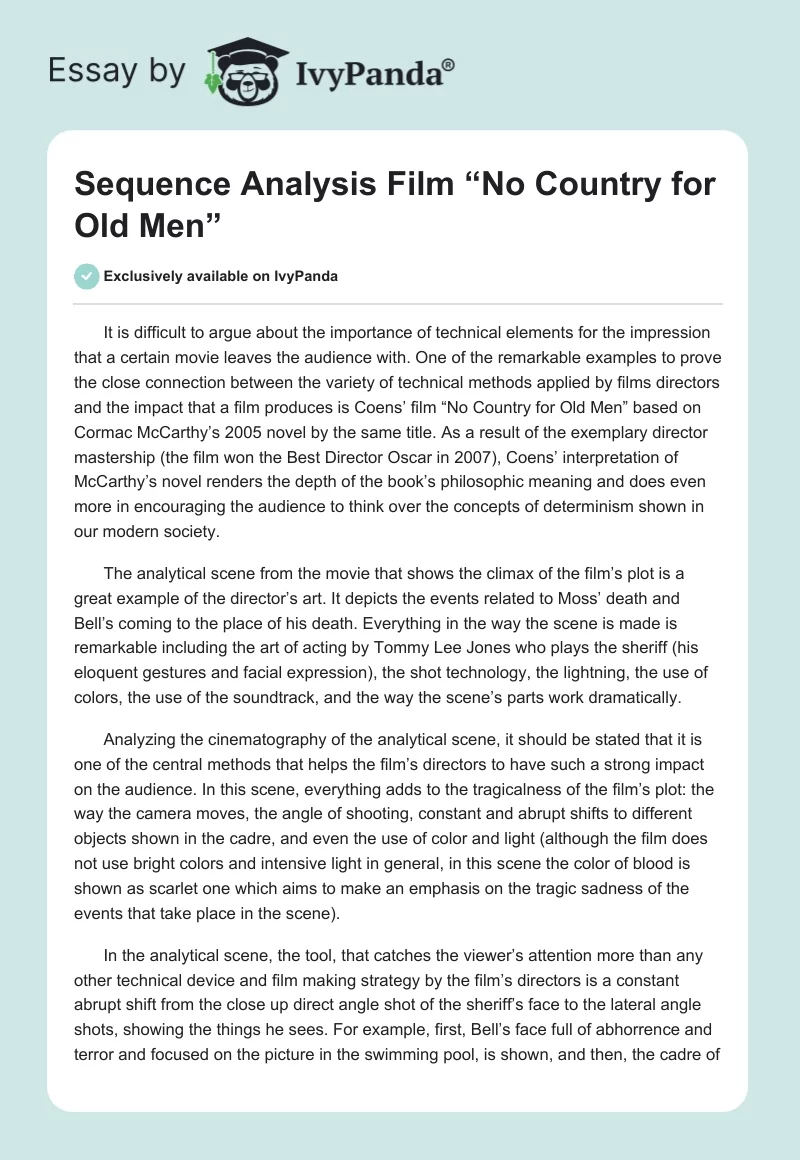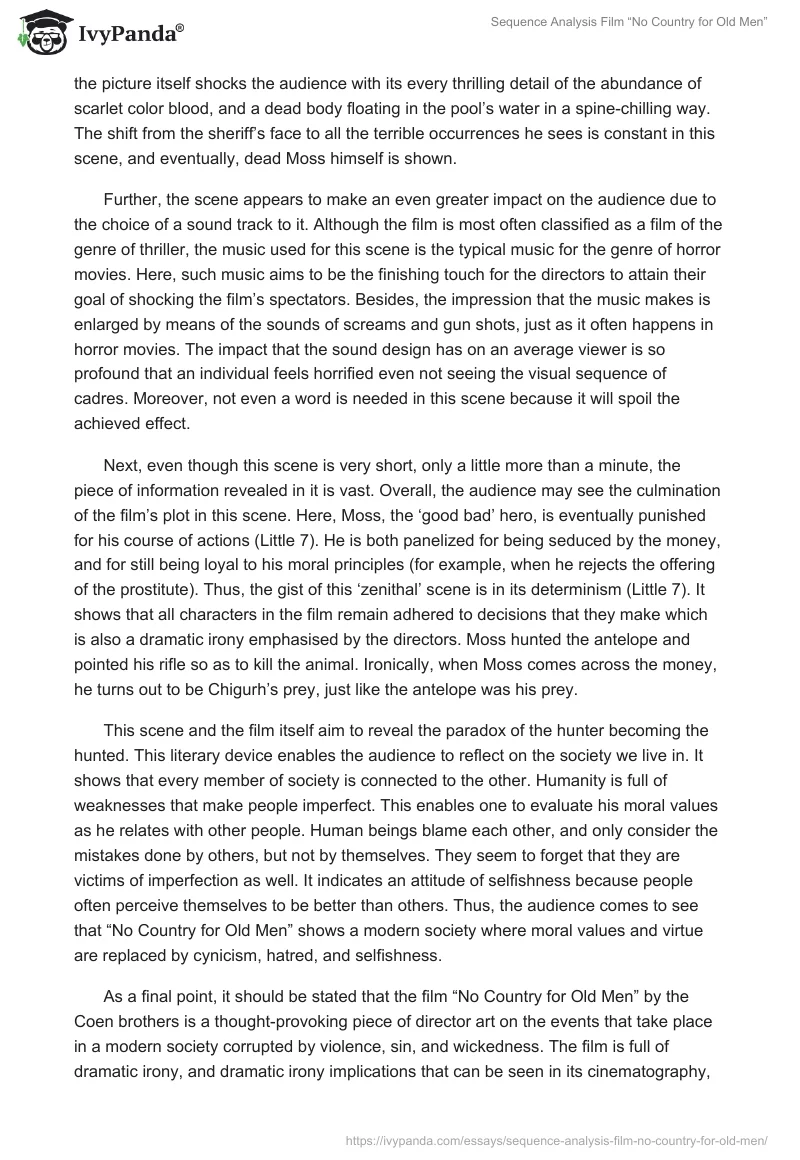It is difficult to argue about the importance of technical elements for the impression that a certain movie leaves the audience with. One of the remarkable examples to prove the close connection between the variety of technical methods applied by films directors and the impact that a film produces is Coens’ film “No Country for Old Men” based on Cormac McCarthy’s 2005 novel by the same title. As a result of the exemplary director mastership (the film won the Best Director Oscar in 2007), Coens’ interpretation of McCarthy’s novel renders the depth of the book’s philosophic meaning and does even more in encouraging the audience to think over the concepts of determinism shown in our modern society.
The analytical scene from the movie that shows the climax of the film’s plot is a great example of the director’s art. It depicts the events related to Moss’ death and Bell’s coming to the place of his death. Everything in the way the scene is made is remarkable including the art of acting by Tommy Lee Jones who plays the sheriff (his eloquent gestures and facial expression), the shot technology, the lightning, the use of colors, the use of the soundtrack, and the way the scene’s parts work dramatically.
Analyzing the cinematography of the analytical scene, it should be stated that it is one of the central methods that helps the film’s directors to have such a strong impact on the audience. In this scene, everything adds to the tragicalness of the film’s plot: the way the camera moves, the angle of shooting, constant and abrupt shifts to different objects shown in the cadre, and even the use of color and light (although the film does not use bright colors and intensive light in general, in this scene the color of blood is shown as scarlet one which aims to make an emphasis on the tragic sadness of the events that take place in the scene).
In the analytical scene, the tool, that catches the viewer’s attention more than any other technical device and film making strategy by the film’s directors is a constant abrupt shift from the close up direct angle shot of the sheriff’s face to the lateral angle shots, showing the things he sees. For example, first, Bell’s face full of abhorrence and terror and focused on the picture in the swimming pool, is shown, and then, the cadre of the picture itself shocks the audience with its every thrilling detail of the abundance of scarlet color blood, and a dead body floating in the pool’s water in a spine-chilling way. The shift from the sheriff’s face to all the terrible occurrences he sees is constant in this scene, and eventually, dead Moss himself is shown.
Further, the scene appears to make an even greater impact on the audience due to the choice of a sound track to it. Although the film is most often classified as a film of the genre of thriller, the music used for this scene is the typical music for the genre of horror movies. Here, such music aims to be the finishing touch for the directors to attain their goal of shocking the film’s spectators. Besides, the impression that the music makes is enlarged by means of the sounds of screams and gun shots, just as it often happens in horror movies. The impact that the sound design has on an average viewer is so profound that an individual feels horrified even not seeing the visual sequence of cadres. Moreover, not even a word is needed in this scene because it will spoil the achieved effect.
Next, even though this scene is very short, only a little more than a minute, the piece of information revealed in it is vast. Overall, the audience may see the culmination of the film’s plot in this scene. Here, Moss, the ‘good bad’ hero, is eventually punished for his course of actions (Little 7). He is both panelized for being seduced by the money, and for still being loyal to his moral principles (for example, when he rejects the offering of the prostitute). Thus, the gist of this ‘zenithal’ scene is in its determinism (Little 7). It shows that all characters in the film remain adhered to decisions that they make which is also a dramatic irony emphasised by the directors. Moss hunted the antelope and pointed his rifle so as to kill the animal. Ironically, when Moss comes across the money, he turns out to be Chigurh’s prey, just like the antelope was his prey.
This scene and the film itself aim to reveal the paradox of the hunter becoming the hunted. This literary device enables the audience to reflect on the society we live in. It shows that every member of society is connected to the other. Humanity is full of weaknesses that make people imperfect. This enables one to evaluate his moral values as he relates with other people. Human beings blame each other, and only consider the mistakes done by others, but not by themselves. They seem to forget that they are victims of imperfection as well. It indicates an attitude of selfishness because people often perceive themselves to be better than others. Thus, the audience comes to see that “No Country for Old Men” shows a modern society where moral values and virtue are replaced by cynicism, hatred, and selfishness.
As a final point, it should be stated that the film “No Country for Old Men” by the Coen brothers is a thought-provoking piece of director art on the events that take place in a modern society corrupted by violence, sin, and wickedness. The film is full of dramatic irony, and dramatic irony implications that can be seen in its cinematography, lighting, the choice of color and sound track, and the actors’ movements and gestures. This is especially evident in the analytical scene that shows the way the film plot’s climax is realized.
References
Little, Suzanne. “No Country for Old Men (part 1)”. Anatomy of a Film (n. d.): 1-15. Print.


